Magnets! There’s a lot about them that we take for granted. Not only do they keep our kids’ latest “A+” on our refrigerators, they also affect our lives on a universal scale. Magnets, put simply, are objects or materials (like iron or steel) that produce a magnetic field with opposite polarities on either end (we call them poles). Like poles repel and opposite poles attract…and that fact happens to lead us in to the game I’m about to cover.
In Yikerz!, players will be placing magnets on the playing area in an attempt to get rid of them all. Where and how they place these magnets determines who will ultimately win the game. Before I touch on the specifics, I’d like to quickly thank Sarah Leach from Wiggles 3D for sending me a free review copy.
Components
Game Boards – There are four boards shaped like a triangle. They can be put together in different ways to change the playing area from game to game.
Yiker Pieces – These magnets are the playing pieces that players will be attempting to place on the board without attracting other pieces.
Setup & Gameplay
First, players will set up the playing area how they’d like using some or all of the triangular playing boards. The manual lists out some combinations for players to use based on skill level, but they are encouraged to experiment. Next, a player is chosen to shuffle the pieces (some have different shapes) and create stacks, each with the same number of pieces (if possible). Any leftovers are put aside and won’t be used. Each player takes a stack and the person who shuffled the pieces will go first.
A turn consists of a player choosing one of their pieces from their pool and placing it onto the board. While they won’t be able to physically touch any pieces that have been played, they can use their playing piece to move other pieces around via their magnetic fields. The chance of this happening increases as the board fills up with pieces. If a player places a piece that causes any of the pieces to “collapse” or come together, they must remove those pieces and place them into their own pool.
When a player is down to one piece, they must announce it by saying “Last Yiker” or “Last Piece”…not following this rule results in a penalty of drawing two pieces from the board (think “UNO”). The first person to get rid of all of their pieces (without causing a collapse with their last piece) wins the game!
The above is simply an overview of the game. To see the rules in greater detail, you can check out the manual, located here:
The Review
First, I’d like to commend this game for its flexibility. Having four separate player boards allows players to come up with their own battlegrounds in which to fight. The manual lists out nineteen board configurations, but there’s obviously many more that can be created with a little imagination. There’s also a solitaire, speed game, high stakes, and win, place or show variant listed in the manual to keep things interesting. I’m sure that creative players will be able to come up with their own variants to best suit their needs, should they want to.
The components are colorful and well made. The player boards themselves remind me of thin mouse pads and the magnets are pretty solid and heavy. However, they are small enough so that they fit into an easy to carry pouch, making it an ideal travel game. Magnets have been known to mess with computer hardware, so keep your laptop and other sensitive equipment away from the game if at all possible. I can’t confirm or deny if the magnets in this game could cause trouble, but better to be safe than sorry.
The different strategies one could employ in this game can be staggering. The board changes with each move, so players will be forced to adapt to their new environment as they place each piece. With the right placement, players can set traps for each other to really ruin their day. It comes down to whoever can manipulate the magnetic fields on the board, and I have to say that science in regards to magnetism couldn’t be more fun.
It’s safe to say that the kids really had a fun time with Yikerz! We played multiple games as each one took about ten to fifteen minutes to play. It was fun watching Vinnie (11) jump in his seat every time one of his piece placements resulted in a collapse. While he was enjoying the experience of manipulating pieces, I was enjoying the opening it gave me to educate him a little on magnets and how magnetic fields worked. Anthony (16) was much more into placing his pieces in ways that would mess me up and limit my piece placement. I could tell that he was really getting into the game when he started experimenting with his pieces by placing them on their different sides.
Overall, Yikerz! is a fun game that borders casual and strategic play. It is light enough to where players don’t have to think about hidden and complex rules, but deep enough to where players will be giving some thought to the one move that they will be playing on their turn. It promotes critical thinking and stays fresh from game to game. If playing with magnets in a strategic way is something that might appeal to you, then give this game a go!
Final Verdict: 7/10
You can read more about “Yikerz!” by visiting the following websites:
—

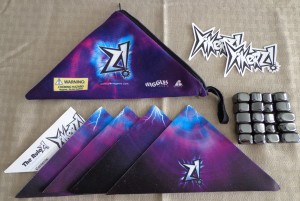
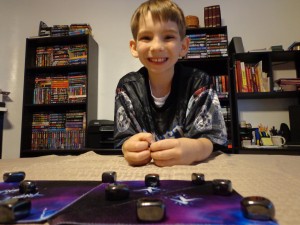
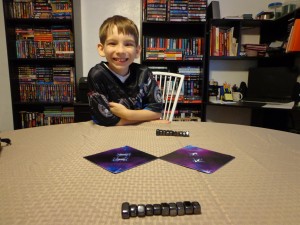
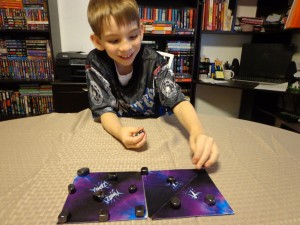
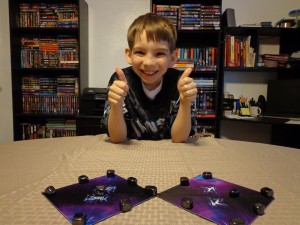
I found your website very entertaining and informative. It’s nice to see that games can become a positive focal point for a family rather then something that can take them apart. My son and I get to spend our summers together and we always find time to play various board games and activities outside. That said, I recently wrote an article about the opposite affect this had as well:
http://www.jagerfoods.com/books/confessions-of-a-bubble-buster-addict/#comment-3922
The outcome here was one of selfishness that led to alienation on my part.
I’m glad I found your site and look forward to future posts.